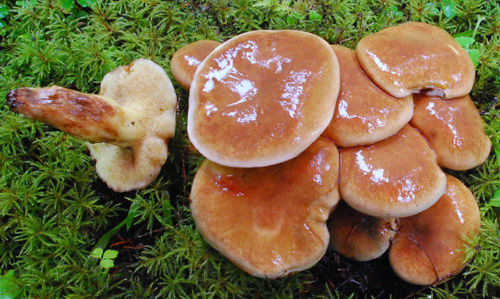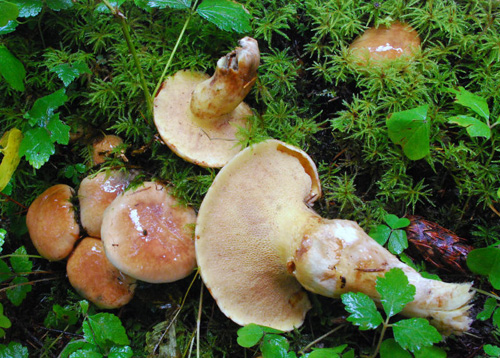Suillus Adans.
A number of species are known in Europe. Fruitbody boletoid without or with partial veil, and then leaving a ring on the stipe. Cap in most species more or less viscid. Stipe solid.
Suillus imitatus A.H. Sm. & Thiers
Description
Known to me only from the literature. Fruitbodies with partial veil, soon disrupting and leaving a ring in the upper part of the stipe. Cap up to 12 cm, brown to reddish brown, usually paler towards the margin, surface smooth and distinctly viscid. Stipe cylindrical or slightly swollen below, solid, dirty whitish to cream, often dark spotted, below the tubes with more or less developed whitish ring. Flesh yellowish to yellowish, unchanging when exposed to air. Tubes short, decurrent, pale yellow to yellow. Pores more or less angular, concolorous with the tubes, darkening when bruised. Smell not distinctive. Taste not distinctive. Spores 7–9 ´ 4–4.5 μm.
Habitat. Coniferous forests, said to be associated with pines but also with Douglas’ fir (Pseudotsuga).
Distribution. North American fungus that has not yet been found in Europe but might be present and should be looked for.
Similarity. Compare with the other Pseudotsuga-associated species of the genus – Suillus lakei, S. caerulescens and S. ponderosus. Due to its specific habitus Suillus immitatus might superficially resemble some of the members of Suillus sect. Larigni, which grow only under larch (Larix).
Photographs

Fruitbodies of Suillus imitatus. (photo D. Bojantchev)

Fruitbodies of Suillus imitatus. (photo D. Bojantchev)
Important literature
Smith, A.H. & Thiers, H.D. 1964. A contribution toward a monograph of North American species of Suillus. Privately published, Ann Arbor.
Thiers, H.D. 1975. California mushrooms. A field guide to the boletes. Hafner Press, New York.